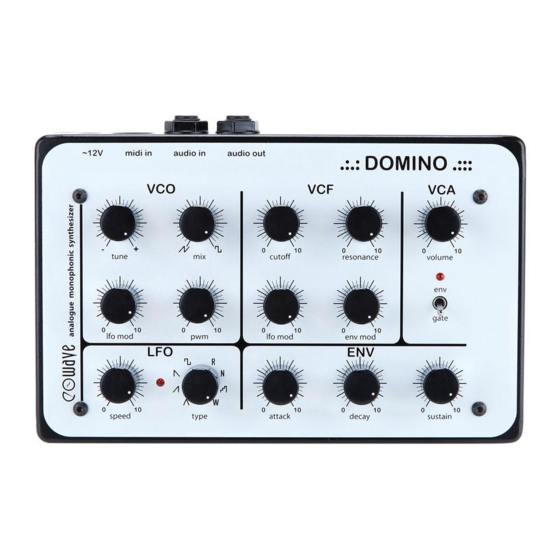
Advertisement
Quick Links
?
Connections
1/ Connect the power supply AC 12 V to the powerplug input. The
LFO LED will light up and blink.
2/ Connect the Domino audio out to your sound system (jack 6,35
mm - 1/4").
3/ To use the Domino like an effect processor, connect the audio in
to an external sound source like another synth. it will disconnect
the internal VCO
4/ Connect the MIDI in to the MIDI out of your MIDI keyboard
or to a MIDI sequencer.
The VCO is the Voltage Controlled Oscillator, which creates continuous
waveforms from saw to square. The VCO is the sound source of the
syntheziser.
Tune: -/+ 7 semitones.
The VCO likes it hot!!!
Mix: There are 2 types of wave-
forms from the VCO (saw and
Allow 1/2 hour pre-heating before the
square). They can be mixed to go
final tuning. In the first hour, the tune
continuously from saw to square.
will be going a couple of herz lower.
The level is a bit lower on mid
position for a cleaner sound.
Lfo mod is the LFO modulation amount of the LFO on the pitch.
Pwm is the Pulse Width modulation amount of the LFO on the pwm.
In the need for transposition
To transpose the sound more than 7 semitones, use the transpose
function of your keyboard, the internal MIDI to CV converter range
from MIDI note 12 to 108, which represents 8 octaves.
.:.:DOMINO.:::
Rules of the game
by
?
ENV = Envelope
The envelope generator generates the control voltage applied to the VCF
and the VCA, thereby controlling the volume and the tone color of each
note. This output voltage is generated when you press a key. The analogue
envelope range is from 1ms to 10s with attack, decay/release, sustain.
Attack
The attack knob sets the time required for the voltage to reach it' s maxi-
mum from the moment the key is pressed down.
Decay/Release
The decay knob determines the time required for the voltage to drop from
the maximum to the sustain level. When the sustain level is high, the
envelope curve does not change by adjusting the decay time. Note that the
decay also affects the time of release of the envelope.
Sustain
The sustain knob determines the sustain level to which the voltage falls at
the end of the decay time. The sustain is maintained during the gate time.
Multiple Trigger Mode
CC21 activates the Multiple Trigger Mode. In this mode, the envelope
is retriggered at each new note that is played.
Per default, the Domino is set on Single Trigger Mode.
VCA = Voltage Controlled Amplifier
The VCA controls the volume (amplitude) of the sound and is controlled by the
output voltage from the envelope generator.
env/gate switch
This selector switch enables to select whether to control the VCA by
the signal from the envelope generator or by the gate signal. When
the switch is down, Gate is on. When the switch is up, envelope is on.
Another additional feature:
there is an arpeggiator inside!
The internal arpeggiator is be activated by MIDI CC4,
CC5 and CC6.
CC4 sets the direction: up, down, up&down or sequancial
(follows the played notes).
CC5 activates the arpegiator (off - 1 oct - 2 oct - 3 oct)
The envelope LED in the VCA section
CC6 activates the latch mode (on - off). In latch mode
shows the envelope activity. When the
off, only the notes being played will be arpeggiated. In
switch is up, the VCA is controlled by
latch mode on, any notes played are latched (memorized)
the envelope.
and will continue to be arpeggiated even if they are not
being played anymore.
The arpeggiator is controlled by the LFO speed and
therefore it can be synced to a midi clock.
Glide!
Per default, the glide is activated when notes are played
legato. It can be off or continuously on.
CC2 sets the glide off/legato only/on.
CC3 sets the glide time.
The last set-up is saved in a non-volatile memory.
Accent feature!
Velocity values above 120 are recognized as an accent.
VCF = Voltage Controlled Filter
The DOMINO VCF is a 24dB resonant low-pass filter.
Cutoff
The cutoff knob determines the cutoff frequency of the VCF.
In its highiest position (10), the sound will pass unchanged. As
you lower the knob, the frequencies in the higher pitch range
will be cut, fading the sound out in its lowest position (0).
Resonance
The resonance knob will emphasize the frequency at the point
set with the cutoff. As you raise the knob, certain harmonics
are boosted and the sound will be more unusual, more electro-
nic in its nature. If setting the resonance knob to the high
position and move the cutoff knob, you can obtain a type of
sound that is impossible to be reproduces by any other musical
instrument. At its highest level, self oscilation will begin (at
the cutoff frequency).
Env mod
Env mod controls how much the cutoff frequency is affected
by the envelope.
lfo mod
This controls how much the cutoff frequency is affected by
the LFO.
Cool tips!
Advertisement

Summary of Contents for Eowave Domino
- Page 1 - 1/4”). lfo mod 3/ To use the Domino like an effect processor, connect the audio in This controls how much the cutoff frequency is affected by to an external sound source like another synth. it will disconnect the LFO.
- Page 2 .:.:DOMINO.::: Support Contact eowave La Cure - 58110 Tintury - France info@eowave.com - ph: +33/6 61 70 20 50 Cautions Only use a AC 12V 1A power supply MIDI Clock time table Setting a new MIDI channel MIDI Implementation Chart...


Need help?
Do you have a question about the Domino and is the answer not in the manual?
Questions and answers